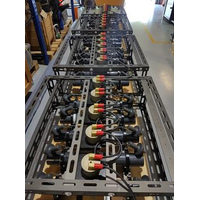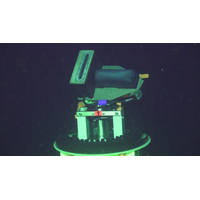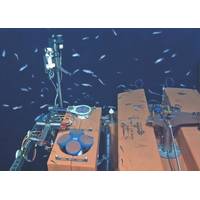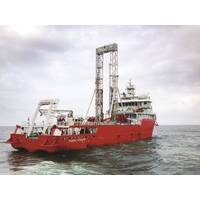
OSIL's Deep-Sea Mining Data Tools
, in addition to a programmable automated water sampling system which can be married with a range of instruments to provide data on water quality parameters such as turbidity, dissolved oxygen or the presence of hydrocarbons.All sampling equipment can be adapted to include the ability to sample for gas hydrates, and can be monitored visually using the OSIL deep-sea camera system with dimmable lights to allow for adjustments for different visibility conditions, which can include additional battery packs for extended seabed observation

MultiBeam EchoSounder Enables First-of-its-kind Research
Increasingly, methane emissions from the seafloor are of greater interest as concern over global warming increases.Large quantities of the potent greenhouse gas methane are trapped within the seafloor in the form of so-called gas hydrates, solid ice-like deposits, which are only stable at particular conditions of high pressure and low temperature. As a result, only a small volume of methane bubbles up into the ocean, and therefore the quantity reaching the atmosphere is not threatening despite its greenhouse effect.However, there is a concern that rising ocean temperatures could lead seafloor methane

Major Gas Hydrate Mapping Campaign Completed in Japan
Ocean Floor Geophysics Inc. (OFG), in cooperation with Fukada Salvage and Marine Works Co. Ltd. (Fukada), has completed a third high resolution Controlled Source Electromagnetic (CSEM) survey of near surface gas hydrates using the Scripps Institution of Oceanography (Scripps) Vulcan system for the National Institute of Advanced Industrial Science and Technology (AIST) in Japanese waters.Following the CSEM surveys and 3D inversion models completed in 2014 and 2015, the 2017 survey comprised more than 413 line kilometers of high resolution data collected in depths up to 1,640 m from the Fukada vessel
Fugro Supporting Seabed Mining Exploration
leading technology, technical capabilities and track record of success make it the perfect partner to assist DeepGreen and Nauru Ocean Resources Inc. to begin producing metals for our future,” said Gerard Barron, CEO of DeepGreen Metals Inc.Dan McConnell, Fugro’s global product manager for gas hydrates and marine minerals added, “Fugro has much to offer in terms of specialized ultra-deepwater survey, resource assessment and oceanographic and environmental studies. We look forward to working with NORI and DeepGreen Metals Inc. and demonstrating value through this, our first ever project
Fugro Commences Deep Sea Mining Support
, technical capabilities and track record of success make it the perfect partner to assist DeepGreen and Nauru Ocean Resources Inc. to begin producing metals for our future,” said Gerard Barron, CEO of DeepGreen Metals Inc. Dan McConnell, Fugro’s global product manager for gas hydrates and marine minerals added, “Fugro has much to offer in terms of specialised ultra-deepwater survey, resource assessment and oceanographic and environmental studies. We look forward to working with NORI and DeepGreen Metals Inc. and demonstrating value through this, our first ever project

ADCPs: Action in OOI's Cabled Observatory
ADCP data. One example is a bio-geological study at the Southern Hydrate Ridge (1B). Marine geologists at the University of Washington are using the ADCP’s returning acoustic echoes to see bubble plumes of methane. The plumes seep from gas hydrate deposits in the seabed. Gas hydrates are a solid ice-like form of water that contains methane molecules. These deposits support biological communities on and within the sediments. The ADCP profiles show bubble plumes through much of the water column. One hypothesis is that these rising plumes of methane might boost

Fugro Returns to China for Gas Hydrate Research
Sea. The contract is valued at approximately $40 million and is expected to commence in the second quarter of 2018. The gas hydrate field research program is the fifth that Fugro will undertake for GMGS, and the two companies have worked together in this field of research since 2007. Gas hydrates, “frozen” gas-water solids resembling ice, may be an important source of future energy. Operated from drilling vessel, Fugro Voyager, the site characterization program comprises logging while drilling, pressure coring and geotechnical sampling. The report and assessment of
Partners Aim to Advance Methane Harvesting Tech
1,742 gas chimney structures in the Japan Sea. Now, as the study concerning harvesting technology for the hydrates, the national project was launched in FY2016. MES has joined it with MHWirth and other partners. MES has wide range experiences of R&D on behaviors of gas hydrates and manufacturing of floating facilities. MHWirth has significant expertise for subsea mining technology and offshore drilling systems including services. This powerful collaboration will pave the way for the success of the hydrates harvesting. In addition
Methane: The Arctic's Buried Treasure
treasure: methane Trapped beneath permafrost and ocean sediments, the release of the world’s largest natural gas resource, methane, has become a hot topic for international research. As rising temperatures continue to warm the Arctic region, the vast frozen fields of gas, known as gas hydrates, grow unstable beneath the retreating ice. The Centre for Arctic Gas Hydrate, Environment, and Climate (CAGE) strives to address one of the greatest scientific uncertainties: how much greenhouse gas threatens to escape the sub-seabed sediments and what will this mean for (1) the global climate

 February 2025
February 2025





